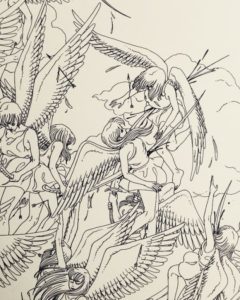Flash fiction is a story that contains less than one thousand words, according to a common definition. It is a complete story, not a fragment, told in language that may be concise and poetic but is still prose. It uses the techniques of fiction—dialogue, plot, characters, development, symbols, a clear narrative voice, and maybe a twist at the end. Flash implies more than it says, suggests a larger world, and leaves the reader eager to know more.
This definition excludes some flash being published today, notably the work of Lydia Davis. Can any definition take in the wide range of styles? We live in a moment of shifting taste, when standards give way to experiments, and fashion rules capriciously. The literary aphasia of Lydia Davis may be haute couture, like a starved runway model clad in adorable rags.
To extend the clothing metaphor, flash lacks some of the elements of a well-dressed story, such as explanatory background, stage-setting, and lavish description. Some critics and writers believe that any short story should dispense with these and concentrate instead on one or a few characters, one dramatic scene, and one decisive moment. Subplots are forbidden. Description should be minimal. Select the significant detail that evokes all the rest. Edgar Allan Poe in reviewing Nathaniel Hawthorne’s Twice-Told Tales recommends “a certain unique or single effect” to which all the elements of the “design” contribute.
In daily life, we tag people. We sort them by gender, age, color, height, job, and place of origin. We pick something a person wears, such as a hat, or something they do, such as a nervous habit. A business owner I knew, a middle-aged fat man known to be stingy, often thrust his right hand in a pocket full of coins and thrashed noisily. Beyond characters, the selective method leads to synecdoche, where the part stands for the whole, and to symbolism, where an object stands for an idea. Weather makes an appearance, to set the mood and suggest a set of circumstances—drought for poverty, or cold for the absence of a love one.
Is flash fiction new? The term dates from the late twentieth century. It implies that the story is over in a flash, with a hint of brightness and quick pace. Other names from the same period are “short short stories” and “sudden fiction.” The Hungarian writer István Örkény (1912-1979) published “one minute stories” in newspapers, so called because they took that long to read. An American online magazine that publishes flash calls itself Smokelong Quarterly, because you can read a story in the time it takes to smoke a cigarette.
Did flash arise in the computer age, as a figment of the internet? Many people suppose it is a natural response to a shrinking attention span. Everyone is busy, according to this cliché, with too many demands on their time to squander it in reading fiction. Never mind that there is no evidence of a change in adult mental stamina in the past thirty years. As consumers, we are greedy, impatient, and easily distracted, children who want it now.
The idea of flash as modern echoes something new, however, the online magazine where it frequently appears. And many of the people who publish, read, and write for online magazines are young, willing to try new things, and eager to subvert the established order. Compared to paper and print, digital publishing offers cheap, unlimited space, so it ought to favor long, digressive forms. But young editors, who also write for their own or other online magazines, prefer the short form. And the amount of text that a tablet or phone screen displays is small. A friend told me that he stopped reading stories for this reason, and because stories strained his monthly data allowance. Maybe the electronic age does favor flash.
The vignette, episode, list, sketch, anecdote, and profile are related types of very short prose. The distinction is in the lack of change or forward motion. A vignette, for example, may be too brief to show a character in action. A sketch may be a static description of a place or a situation. An anecdote illustrates a point but does not point beyond, in the way that a parable or an allegory does. A profile is a portrait of a man or woman at a moment in time.
Length and movement aside, what is the difference between a story, a tale, a sketch, a yarn, and an account? Poe says that some of Hawthorne’s tales are really essays. Washington Irving’s The Sketch Book contains classic short stories. Ivan Turgenev’s A Sportsman’s Notebook (or A Sportsman’s Sketches) is a collection of stories linked by the narrator’s hunting trip. The brief notes, scenes, and lists that make up The Pillow Book by Sei Shonagon have emotional depth, understated humor, and sharp observation. The labels we attach to short prose vary over time, are far from precise, and have limited usefulness.
Short prose is in fact prehistoric. It can be traced to Aesop’s Fables, stories in the Hebrew Bible, and ancient myths. Homer’s Odyssey incorporates such stories, altered to fit the hero Odysseus. The One Thousand and One Nights, with the framing device of Scheherazade and the murderous Shahryar, is a collection of ancient tales from India, Persia, the Mideast, and Greece, all told in Arabic.
A more recent precedent in Parisian newspapers of the mid-1800s is the feuilleton—a snippet of urban life. Charles Baudelaire wrote fifty “prose poems” collected in 1869 as Paris Spleen. The distinction between fiction and nonfiction may not apply to flash, which can range from sober factual report to delirious fantasy. Very short pieces often resemble notes from a writer’s journal, bits of daily life that slip into make-believe.
Some magazines and writing competitions ask for prose less than three hundred or less than five hundred words. Called “micro fiction,” this may amount to one paragraph or one sentence. There is even a vogue for “nano fiction,” from the Greek word for “dwarf.” The term “prose poems” is obsolete, as the overwhelming literary preference today is for free verse over rhymed and metrical poems. Hearing a contemporary poem or a micro fiction read aloud, it can be hard to tell whether the piece is printed in lines or a block of type.
Commercial magazines that accept freelance “true stories” limit their length to less than eight hundred words. Told in the first person, these stories are pointed, humorous, and inoffensive. They harken back to the newspaper bits, with a shift from street scenes to domestic life. The Christian Science Monitor, Reader’s Digest, and Saturday Evening Post print them.
Stories told aloud resemble flash fiction, at least when they are short and to the point, not the shaggy-dog type. Live stage performance billed as “storytelling” has caught on during the past few decades. Garrison Keillor’s “News from Lake Wobegon” series of tall tales broadcast on public radio helped to create an audience for these events, and encouraged amateurs to try their skill. As with the “true stories” in magazines, these stories owe their effect to radical selection of details and narrative skips in time. They also benefit from the acting ability of the teller.
Stories recorded for the Moth Radio Hour are rehearsed. Some have been written out and memorized. “True as remembered and affirmed by the storyteller,” they last a few minutes, which correspond to a few pages of text. A collection was published as a book in 2013 as The Moth: 50 True Stories.
American mass-market magazines in the early twentieth century published very short stories. Critics used the phrase “magazine fiction” to disparage them. In a 1960 preface to Winesburg, Ohio, the collection of short stories by Sherwood Anderson, Malcolm Cowley wrote:
American folk tales usually end with a “snapper,” –that is, after starting with the plausible, they progress through the barely possible to the flatly incredible, then wait for a laugh. Magazine fiction used to follow—and much of it still does—a pattern leading to a different sort of snapper, one that calls for a gasp of surprise or relief instead of a guffaw. Anderson broke the pattern by writing stories that . . . had no plots in the usual sense. The tales he told in his Midwestern drawl were not incidents or episodes, they were moments, each complete in itself.
Bearing in mind published examples by Anderson, O. Henry, Anton Chekhov, W. Somerset Maugham, Donald Barthelme, Woody Allen, and David Sedaris, I agree with editors who define flash as up to one thousand five hundred words with a narrative structure. Unlike poetry, which can get by on allusion, suggestion, odd grammar, and sound effects like repetition and rhythm, flash is explicit. The statement it makes, though, may be absurd.
Flash contains an event, an action, a shift, or a change, or in the bitter comic vein of Chekhov, it shows why change is impossible. I do not subscribe to the conflict theory of fiction, but I do believe that a story shows a problem and seeks a solution. The narrative is this search, which is the human search for meaning. The search can succeed or fail. Some readers hail success as inspirational or uplifting, while failure strikes them as a failure on the part of the writer. Other readers see the lack of closure or a clear moral message as a faithful reflection of the real world, the indifference of fate to human wishes.
The flash form is a good exercise for writers, as a first draft can be completed in one or two sittings. Like poetry, flash benefits from images and metaphors, a few significant details, a sense of timing, and a command of language. The first sentence states the theme and sets the tone. The last sentence may or may not come as a shock, but it certainly feels like the end. Everything in between contributes to the effect, and every word pulls its weight. To reach this ideal, however, the writer must ruthlessly cut and revise. Quick though it is to read, finished flash takes a long time to write.
Fantasy and fable appeal to beginners, satire has a venerable literary pedigree, and political screeds get attention online. The realist variety is out of fashion. Much of the flash appearing today is of the moment and easily forgotten. Some of it gets reprinted in anthologies like Short Shorts of 1982, edited by Irving and Ilana Wiener Howe, and the Flash Fiction series that started in 1992, edited by Thomas, Hazuka, Shapard, Merrill, et al. Several old-guard literary magazines in the United States accept flash. Some relegate it to their online editions.
Perhaps the most interesting side of flash is the way it crosses boundaries, both international and literary. Here is a form that appeals to all readers and is open to all writers. What will they think of next?
© Robert Boucheron
Robert Boucheron grew up in Syracuse and Schenectady, and he worked as an architect in New York and Charlottesville. His short stories and essays appear in Bellingham Review, Fiction International, London Journal of Fiction, and other magazines.
Website: www.robertboucheron.com



